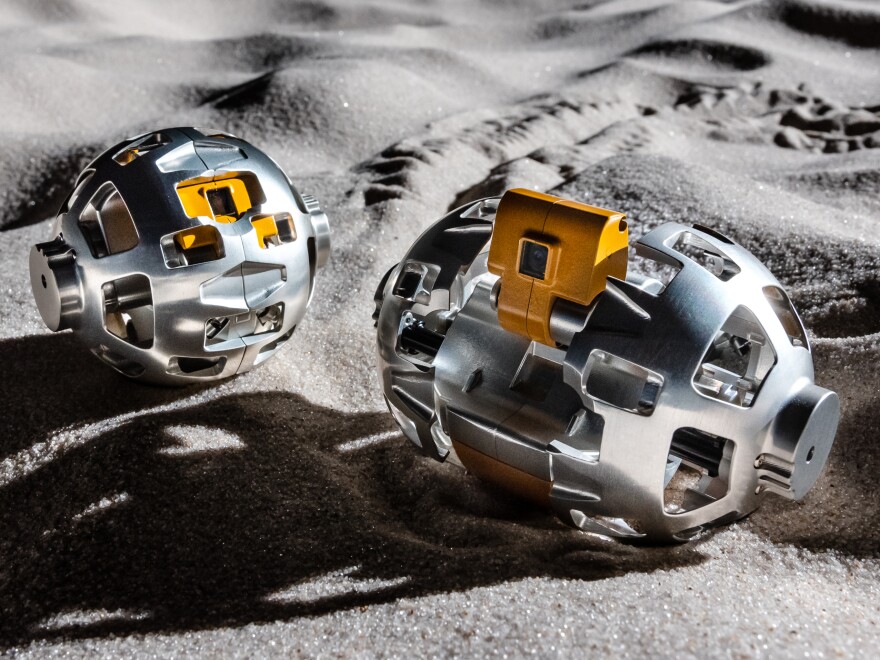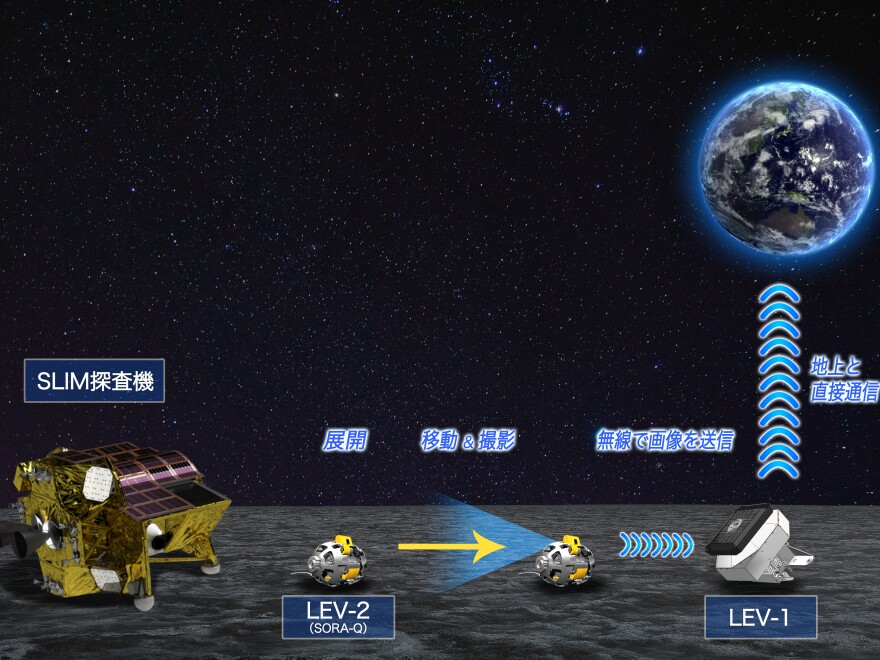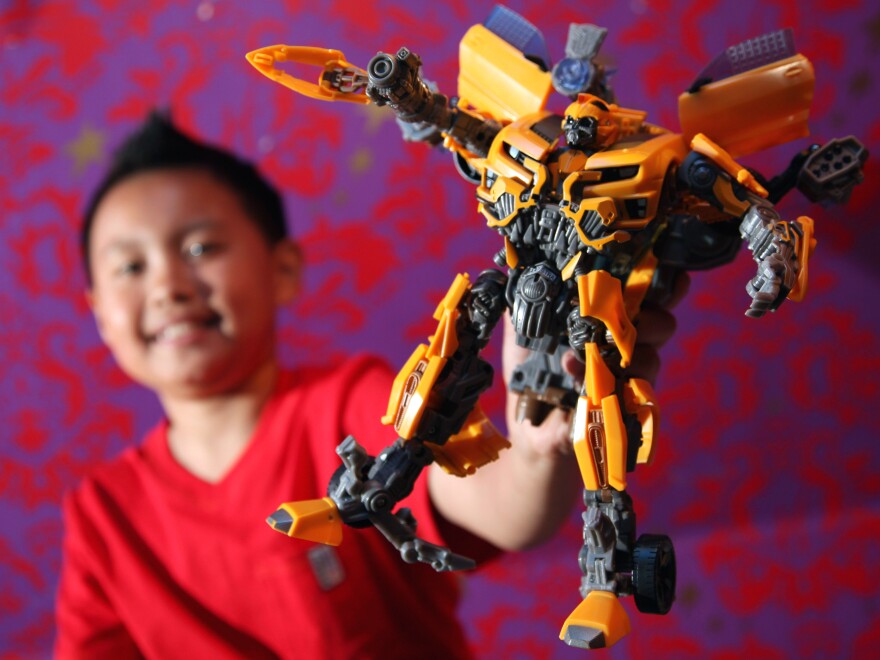Japan is about to attempt one of the hardest tricks in space exploration: a soft landing on the moon. Its "Moon Sniper" mission is set to land on the moon Friday morning, ET — and if all goes well, a robot designed by the company that invented Transformers will rove the lunar surface.
JAXA, the Japanese space agency, is livestreaming video of the lunar descent, starting at 9 a.m. ET Friday. The landing is scheduled for around 10:20 a.m. ET.
Just before the lander touches down, it will eject a robot onto the lunar surface — in hopes that it will take a photo of the newly arrived spacecraft. It would be one of the last actions in what's expected to be a tense sequence, as years of work and planning culminate into one final make-or-break moment.
"The start of the deceleration to the landing on the Moon's surface is expected to be a breathless, numbing 20 minutes of terror!" as JAXA's Kushiki Kenji, the mission's sub-project manager, put it last year.
Japan is looking to become the fifth country to pull off a soft landing on the moon, joining the U.S., China, the former Soviet Union, and India.
It's Japan's second attempt to land its lunar mission. Last April, a Japanese company named ispace apparently failed in its bid to become the first private firm to land a craft on the moon, after losing contact with its lander.
What is the transforming robot on the moon?

JAXA's design team needed to create a lunar probe that was small and light enough to ride to the moon along with the main lander, and also simple and robust enough to work on the rocky, sandy surface. For answers, they looked to a toy company.
Takara Tomy, inventor of the Transformers toys, brought its "knowledge of miniaturization and weight savings" to the space project, the company says, along with the know-how to build mechanisms that transform.
The result is the Lunar Excursion Vehicle-2, nickname: SORA-Q. In its initial spherical form, it has a diameter of around 8 centimeters — making it slightly larger than a baseball. It's one of two LEVs the lander will eject when it's about two meters above the ground.
After hitting the moon's regolith, SORA-Q will transform, springing its two halves apart into independently controlled wheels. In this form, a wishbone-like tail juts from its rear, to help keep it stable. The robot also pops a camera module up from its core.
With the toymaker's help, JAXA "reduced the number of components used in the vehicle as much as possible and increased its reliability," said Hirano Daichi, associate senior researcher at JAXA's Space Exploration Innovation Hub Center.
The small robot will enjoy a burst of activity and fame before its battery dies on the moon. It only has enough juice for around two hours of activity, as The New Yorker reported.
Along with Takara Tomy, the robot was built with the help of Doshisha University; it uses a control board and camera that came from Sony. Both JAXA and the toy company say they hope the little robot inspires children to pursue interests in science and space exploration. Takara Tomy has released a civilian version of the robot in Japan.
What about the lander?

The Smart Lander for Investigating Moon, or SLIM, was launched into space from the Tanegashima Space Center in Japan last September. It took months to reach the moon: after an initial pass in October, the craft slung through a wide elliptical path before achieving lunar orbit on Dec. 25.
When the lander touches down, its arrival on the moon will be cushioned by five unique shock absorbers that look like a cross between chain mail and an inverted geodesic dome. The parts were 3D-printed with aluminum, creating a spongelike grid that will deform when it comes in contact with the ground.
Part of the SLIM mission's goal is to practice "pinpoint landing" — reaching highly specific targets on the lunar surface, putting landers in areas that may hold resources or unique geology. The lander is meant to reach a spot that's within 100 meters of its target: sloped ground next to the Shioli crater near the moon's Mare Nectaris (Sea of Nectar).
"The landing accuracy of conventional lunar landers is several or sometimes a dozen kilometers," according to JAXA's press kit about the lander's mission.
JAXA has previously succeeded in placing a probe on an asteroid. But the agency says putting a craft on the moon is much more difficult, as "the dynamics are completely different since the gravity of asteroids is significantly lower." Unlike on an asteroid, the agency says, its lander isn't able to nudge slowly down to the moon's surface, and rise again if it's necessary to restart the process.
What is Takara Tomy?

Longtime Japanese toymaker TOMY Company Ltd. was founded on Feb. 2, 1924, by Eiichiro Tomiyama. It absorbed the Takara toy company in 2006.
Takara created what would become known in the U.S. as the Transformers — alien robots that can disguise themselves as cars and other machines. After Takara released the Diaclone and Micro Change lines, it licensed the toys to Hasbro in the 1980s, which branded the toys as Transformers.
Of course, the moon has played a pivotal role in the mythology of the Transformers' stories, most famously in the 2011 Michael Bay opus, Transformers: Dark of the Moon. The film one-ups conspiracy theories about the 1969 moon landing by depicting the Apollo 11 mission as a cover story for the U.S. to seek advanced alien technology from another planet: Cybertron, home world of Optimus Prime and the Autobots.
What's next?
This lunar mission is for machines only, but JAXA hopes to change that: It's developing a crewed lunar rover with Toyota that is meant to transport people in a pressurized environment. Scientists want to use data gathered from the SLIM lander and its probes to help prepare the vehicle for the moon's terrain.
Japan is lining up another shot at the moon for 2025, when it plans to launch a rover to the moon's south pole, in hopes of drilling and sampling potential sources of lunar water. In that mission, JAXA is teaming up with India's space agency, which is to supply the lander module.
Efficiency, space and weight are always at a premium in space operations. For the moon mission, the SLIM craft actually got into space via carpool, sharing a ride with the X-ray Imaging and Spectroscopy Mission, a collaboration between JAXA and NASA to look at X-rays emitted by celestial objects.
The "Moon Sniper" mission is just one of the ambitious projects currently seeking to land or send humans to the moon. A private U.S. company, Astrobotic Technology, launched a moon lander earlier this month, but that mission failed.
NASA's Artemis mission aims to bring humans back to the moon, but the U.S. agency recently pushed back plans for a crewed orbital mission to September 2025. NASA plans to land astronauts on the moon one year later, in 2026. Along with Japan, countries such as Russia and Israel have been sending missions to the moon, in something of a reborn space race.
"This is a much, much more serious race and more substantive because there are resources on the moon, and those resources are actually limited," Michelle Hanlon, executive director of the Center for Air and Space Law at the University of Mississippi, told NPR last year. "And countries are racing to get to the moon to get access to those resources because ultimately that is how we're going to have access to the rest of the universe."
Copyright 2024 NPR. To see more, visit https://www.npr.org.


